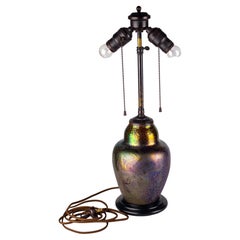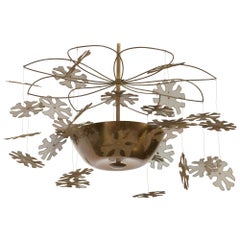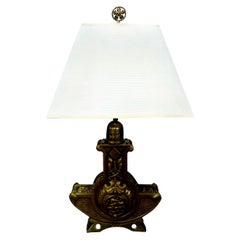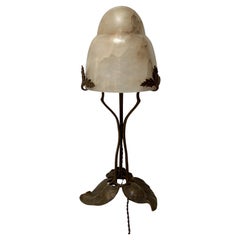Fleurdetroit Lighting
to
2
2
Height
to
Width
to
2
1
1
2
1
1
1
1
1
1
1
1
1
1
1
1
2
2
2
1
1
Art Nouveau Iridescent Earthenware Weller Sicard Lamp Base
By Jacques Sicard
Located in Bloomfield Hills, MI
This stunning lamp base is a converted Art Nouveau Weller Sicard vase. It is a prime example of Sicard's trademark metallic lustre glaze.
One of the p...
Category
Antique Early 1900s American Art Nouveau Table Lamps
Materials
Pottery
Paavo Tynell Chandelier with Snowflakes EARLY Model 9065
By Paavo Tynell
Located in Bloomfield Hills, MI
Made circa 1950. This beautiful and rare Paavo Tynell chandelier is a timeless midcentury feat of design. Best known for his impeccable lighting fixtures and lamps, Tynell was a master craftsman that made elegant forms from brass and was known as “the man who illuminated Finland.”
He found great success in Europe and abroad making notable works throughout the United States such as his lighting design for the UN Secretary General’s office in New York.
A groundbreaking blend of traditional aesthetic with a modern awareness, this chandelier casts warm light through an intricately perforated brass bowl, expertly illuminating the handcut suspended snowflakes and creating an entrancing ambiance.
Pavo Tynell: Chasing Light...
Category
Vintage 1940s Finnish Mid-Century Modern Chandeliers and Pendants
Materials
Brass
Related Items
Austrian Art Nouveau Bronze Lamp
Located in Houston, TX
Lovely period Austrian Art Nouveau bronze table lamp. This beautifully detailed, high quality Austrian bronze lamp has been newly wired and would w...
Category
Vintage 1910s Austrian Art Nouveau Table Lamps
Materials
Bronze
Art Nouveau lamp circa 1910
Located in NANTES, FR
Beautiful Art Nouveau lamp, circa 1910.
Brown-veined alabaster shell.
The base is bronze with floral decoration.
Electric and in perfect condition.
Total Height: 52 cm
Shell Diamete...
Category
Vintage 1910s French Art Nouveau Table Lamps
Materials
Alabaster, Bronze
Chandelier in Paavo Tynell Style
By Paavo Tynell
Located in Long Island City, NY
A chandelier in Paavo Tynell style, probably by Itsu, Finland, circa 1940s-1950s.
Original glass shades with brass decoration. Measures: height 27....
Category
Vintage 1950s Finnish Scandinavian Modern Chandeliers and Pendants
Materials
Glass
Paavo Tynell Style Rare Chandelier, Early 1900s
By Paavo Tynell
Located in Helsinki, Uusimaa
Paavo Tynell style rare chandelier from the early 1900s. Chromed metal frame with milk glass shades. Good vintage condition, minor wear and patina consistent with age and use. Beauti...
Category
Early 20th Century Finnish Art Deco Chandeliers and Pendants
Materials
Chrome
Chandelier by Paavo Tynell
By Taito Oy, Paavo Tynell
Located in Long Island City, NY
A Chandelier designed by Paavo Tynell for Taito Oy, Model 9015. Finland , circa 1940th.
Marked ” OY TAITO AB 9015 ”. Measures : Diameter 23" ; Height 33".
Rewiring available upon r...
Category
Vintage 1940s Finnish Scandinavian Modern Chandeliers and Pendants
Materials
Brass
Art Nouveau Table Lamp, 1910's
Located in Praha, CZ
Beautiful antique Art Nouveau lamp made of copper alloy, patinated to old bronze. Produced in former Czechoslovakia in the very beginning of 2...
Category
Early 20th Century Czech Art Nouveau Table Lamps
Materials
Metal
Majorelle Art Nouveau Lamp
By Atelier Majorelle
Located in NANTES, FR
Majorelle Art Nouveau lamp
Large lamp around 1900 foot in gilded bronze and lampshade in alabaster.
Very good quality of bronze and pretty floral m...
Category
Early 20th Century French Art Nouveau Table Lamps
Materials
Alabaster, Bronze
Paavo Tynell Chandelier, 1930s
By Paavo Tynell, Taito
Located in Vienna, AT
Early Paavo Tynell model 1855/6 chandelier from the 1930s. Slender wood centerpiece with three cast brass dual-arm branches, each with a tall tapered blown glass diffuser. Nice origi...
Category
Vintage 1930s Finnish Art Deco Chandeliers and Pendants
Materials
Brass
Paavo Tynell Chandelier with Snowflakes Model 9065
By Paavo Tynell
Located in St.Petersburg, FL
A rare and beautiful Paavo Tynell chandelier, circa 1950s. Stamped made in Finland, Taito Oy, 9065.
A note about the artist: "Paavo Viljo Tynell (25 January 1890-13 September 1973) ...
Category
Vintage 1950s Finnish Mid-Century Modern Chandeliers and Pendants
Materials
Brass
Daum Nancy Art Nouveau Lamp
By Daum
Located in NANTES, FR
Daum Nancy Art Nouveau table lamp, circa 1910.
High-quality wrought iron base, stamped (illegible).
Powder tulip signed Daum Nancy.
Electric and in perfect condition.
Height: 40.5 c...
Category
Vintage 1910s French Art Nouveau Table Lamps
Materials
Wrought Iron
Important Paavo Tynell Chandelier Model 9062 in Perfortated Brass, Taito 1950s
By Paavo Tynell, Taito
Located in Helsinki, FI
An important chandelier by world renowned Finnish lighting designer Paavo Tynell. This exceptional lamp is built to impress and is made of full brass with eight perforated shades placed on a large ring held by four arms from the middle while still giving a floating illusion and lightness to the otherwise very heavy lamp. The shade bases penetrate the floating circle to each hold a spring like decoration that is synonym with Paavo Tynell designs along with the perforation on the shades.
This lamp, model 9062 is one of the few Paavo Tynell designs that can steal the show from his iconic snowflake lamps...
Category
Vintage 1950s Finnish Scandinavian Modern Chandeliers and Pendants
Materials
Brass, Metal
$507,404
H 37.41 in Dm 41.34 in
Chandelier by Paavo Tynell
By Paavo Tynell
Located in Long Island City, NY
Model "9029/5" ceiling lamp designed by Paavo Tynell for Taito Oy and destined to the import, engraved "9029/5", "MADE IN FINLAND", "TT" (Import stamp) and "OY. TAITO AB."
5 Edison s...
Category
Vintage 1950s Finnish Scandinavian Modern Chandeliers and Pendants
Materials
Brass



